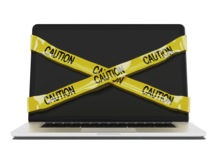It often starts out small – a five-dollar purchase that shows up on in the bank statement, a strange email notification, a hacked social media account. Day in and day out, personal information is scattered around the web, in places you might not even realize. From broadcasting our location on Facebook and Foursquare, to extolling our professional credentials on LinkedIn, and expressing opinions on Twitter and Wordpress, our lives are more of an open book than ever before. So how, as individuals, can we ensure our information is safe? Kinetik I.T. President Josette van Stiphout offers some suggestions.

The most fundamental step, she explains, is making sure no one is spying on you. “For individuals, let's start with something simplistic – really making sure that your computer doesn't have spyware installed. What can happen ‑‑ if you're an individual, and you do online banking, and you're not aware that there is spyware on your computer, they can obtain your bank account numbers, your personal information, and they can access your online financial data.” Take these steps in verifying the security of your computer and accounts:
Computer safety: Make sure that your computer is clean before you do any online transactions related to banking or personal information – install a good anti-spyware software and regularly download the anti-spyware definition updates, or set up automatic updates.
Create a strong, complex password. Microsoft suggests that the stronger your password, the more protected your computer will be from hackers and malicious software. Create an effective password following these guidelines:
· At least twelve characters long.
· Does not contain your user name, real name, or company name.
· Does not contain a complete word.
· Is significantly different from previous passwords.
· Contains characters from each of the following four categories: Capital letters, lower case letters, numbers, and symbols.
Ensure data security: When online, only deal with secure and encrypted websites that are from a credible source. For this final step, van Stiphout explains that simply looking for the https in front of the domain will indicate if your data is encrypted. “Especially when making online purchases, you want to make sure that https prefix is there, and you should see a little lock on the bottom of the toolbar that shows that the session is encrypted,” she said.
She adds, “If you do online purchases, never order from a company that doesn't have a name or address that is verifiable. I always research the company before I do any online transactions with that company.Verify that the company indeed has an address, contact information, that's all verifiable. You should also find out the safety rating of a web site before visiting it. Norton and TrendMircro are good will have safety ratings. When in doubt, don't visit the site. Better safe than sorry. Spyware and viruses can be hard to get rid of. Your personal information can be compromised and you could lose date if your computer has to be rebuilt with no adequate data backup. This all takes time and can be very costly.
Last but not least: Be aware of phishing emails/scams, where you make receive fake notifications from an organization that is posing itself as a legitimate company. These notifications are designed to encourage you to click on links and steal your identity by acquiring information such as your username, password etc.
Kinetik Information Technology is a premier provider of internet and information technology solutions and resources that move our clients forward. Kinetik I.T.'s mission is to design and develop world-class web sites, internet marketing strategies, web, database, custom software & online shopping cart applications; as well as to provide the resources and network technology that move our clients forward, enabling our clients to reach their full business potential.
To learn more about services and products, and to stay up to date with Kinetik I.T., visit www.Kinetik-IT.com or follow Kinetik I.T. on Facebook, LinkedInor Twitter.